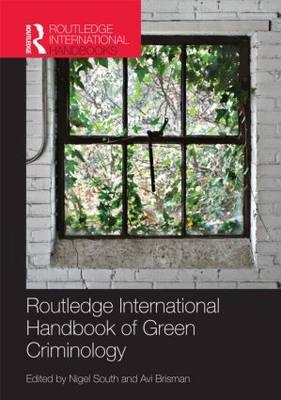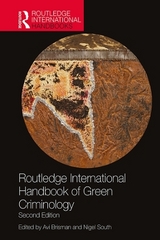
Routledge International Handbook of Green Criminology
Routledge (Verlag)
978-0-415-67882-7 (ISBN)
- Titel erscheint in neuer Auflage
- Artikel merken
With contributions from leading international green criminologists and scholars in related fields, the Handbook examines a wide range of substantive issues, including:
climate change
corporate criminality and impacts on the environment
environmental justice
media representations
pollution (e.g. air, water)
questions of responsibility and risk
wildlife trafficking
The chapters explore green criminology in depth, its theory, history and development, as well as methodological concerns for this area of academic interest. With examples of environmental crimes, harms, and threats from Africa, Asia, Australia, Eastern Europe, South America, the United Kingdom, and the United States, this book will serve as a vital resource for international scholars and students in criminology, sociology, law and socio-legal studies, as well as environmental science, environmental studies, politics and international relations.
Nigel South is Professor of Sociology, a member of the Human Rights Centre and Centre for Criminology, and a Pro-Vice-Chancellor at the University of Essex, England. He has served on various editorial boards and governing bodies and has published over twenty books and journal special issues including several contributing to the development of green criminology. Avi Brisman is an assistant professor in the School of Justice Studies at Eastern Kentucky University in Richmond, KY (USA). His writing has appeared in such journals as Crime, Law and Social Change, Crime Media Culture, Critical Criminology, and Western Criminology Review, among others.
Introduction: Horizons, Issues and Relationships in Green Criminology by Avi Brisman and Nigel South Part I: History, Theory and Methods 1. A Guide to a Green Criminology by Nigel South, Avi Brisman, and Piers Beirne 2. Reflections on Green Criminology and its Boundaries: Comparing Environmental and Criminal Victimization and Considering Crime from an Eco-city Perspective by Michael J. Lynch 3. The Ordinary Acts that Contribute to Ecocide: A Criminological Analysis by Robert Agnew 4. The Contemporary Horizon of Green Criminology by Lorenzo Natali 5. Innovative Approaches to Researching Environmental Crime by Diane Heckenberg and Rob White Part II: International and Transnational Issues for a Green Criminology 6. Conservation Criminology and the "General Accident" of Climate Change by Mark Halsey 7. The Criminogenic Consequences of Climate Change: Blurring the Boundaries between Offenders and Victims by Matthew Hall and Stephen Farrall 8. Air Crimes and Atmospheric Justice by Reece Walters 9. Crude Laws: Treadmill of Production and State Variations in Civil and Criminal Liability for Oil Discharges in Navigable Waters by Matthew B. Greife and Paul B. Stretesky 10. Food Crime: A Green Criminology Perspective by Hazel Croall 11. Nature for Rehabilitating Offenders and Facilitating Therapeutic Outcomes for Youth at Risk by Jules Pretty, Carly Wood, Rachel Hine and Jo Barton Part III: Region-Specific Problems: Some Case Studies 12. The Amazon Rainforest: A Green Criminological Perspective by Tim Boekhout van Solinge and Karlijn Kuijpers 13. The Control of Conflict Minerals in Africa and a Preliminary Assessment of the Dodd-Frank Wall Street Reform and Consumer Act by Richard D. Clark 14. Green Issues in South-Eastern Europe by Katja Eman and Gorazd Meško Part IV: Relationships in Green Criminology: Environment and Economy 15. Eco-Global Criminology and the Political Economy of Environmental Harm by Rob White 16. The Environment and the Crimes of the Economy by Vincenzo Ruggiero 17. Evading Responsibility for Green Harm: State-Corporate Exploitation of Race, Class, and Gender Inequality by Emily Gaarder 18. Public Perceptions of Corporate Environmental Crime: Assessing the Impact of Economic Insecurity on Willingness to Impose Punishment for Pollution by Tara O’Connor Shelley and Michael J. Hogan Part V: Relationships in Green Criminology: Humans and Non-Human Species 19. Uncovering the Significance of and Motivation for Wildlife Trafficking by Tanya Wyatt 20. Victimisation of Women, Children and Non-Human Species Through Trafficking and Trade: Crimes Understood Through an Ecofeminist Perspective by Ragnhild Sollund 21. Environmental Justice, Animal Rights, and Total Liberation: From Conflict and Distance to Points of Common Focus by David N. Pellow Part VI: Relationships in Green Criminology: Environment and Culture 22. Tangled Up in Green: Cultural Criminology and Green Criminology by Jeff Ferrell 23. "This is the North, Where We Do What We Want:" Popular Green Criminology and "Little Red Riding Hood" Films by Steven Kohm and Pauline Greenhill 24. Coastline Conflict: Implementing Environmental Law in Salvador da Bahia, Brazil by Stephanie Kane 25. Matter All Over the Place: Litter, Criminology and Criminal Justice by Nic Groombridge. Conclusion: The Planned Obsolescence of Planet Earth? How Green Criminology Can Help Us Learn From Experience and Contribute to Our Future by Avi Brisman and Nigel South
| Reihe/Serie | Routledge International Handbooks |
|---|---|
| Zusatzinfo | 3 Line drawings, black and white; 7 Halftones, black and white; 14 Tables, black and white; 10 Illustrations, black and white |
| Verlagsort | London |
| Sprache | englisch |
| Maße | 174 x 246 mm |
| Gewicht | 942 g |
| Themenwelt | Naturwissenschaften ► Biologie ► Ökologie / Naturschutz |
| Recht / Steuern ► Strafrecht ► Kriminologie | |
| Sozialwissenschaften ► Soziologie | |
| Technik ► Umwelttechnik / Biotechnologie | |
| ISBN-10 | 0-415-67882-X / 041567882X |
| ISBN-13 | 978-0-415-67882-7 / 9780415678827 |
| Zustand | Neuware |
| Informationen gemäß Produktsicherheitsverordnung (GPSR) | |
| Haben Sie eine Frage zum Produkt? |
aus dem Bereich



